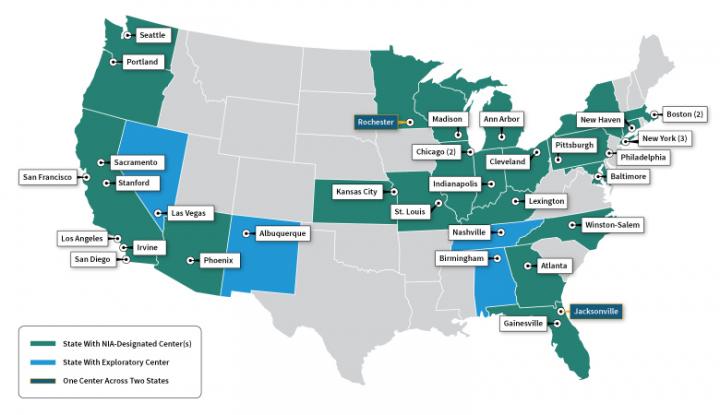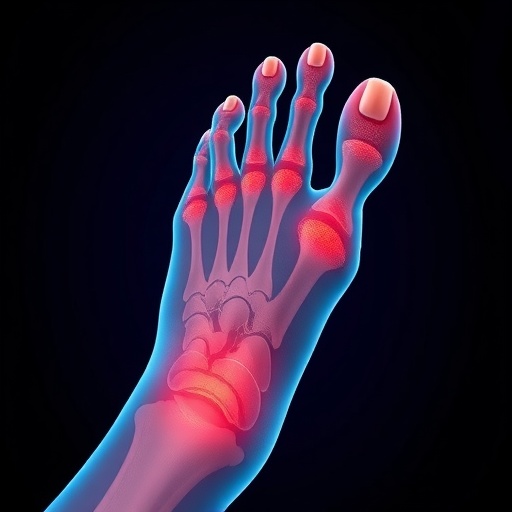Four newly funded exploratory centers will bolster diversity: geographic, community and scientific

Credit: NIH/National Institute on Aging
To further incentivize innovative ideas and opportunities in Alzheimer’s disease and related dementias research, the National Institute on Aging (NIA), part of the National Institutes of Health, has funded four exploratory Alzheimer’s Disease Research Centers (ADRCs). These new centers will broaden current ADRC research initiatives with underrepresented populations such as African Americans, Native Americans, and those in rural communities — all of which have different risk factors for developing these devastating diseases.
The NIA funding for these exploratory centers, expected to total $13.6 million over three years, expands the ADRC network into four additional states. The new locations are at the Cleveland Clinic Lou Ruvo Center for Brain Health in Las Vegas, Nevada; University of Alabama at Birmingham; University of New Mexico in Albuquerque; and Vanderbilt University in Nashville, Tennessee.
“The NIA-funded ADRC program is nationally recognized for excellence on many levels, such as fostering research collaboration, promoting data sharing and open science, and providing information and research participation opportunities for people and families most affected by Alzheimer’s and related dementias,” said Nina Silverberg, Ph. D., director of the ADRC program at NIA. “These four new centers mark a strategic expansion that will benefit the research community and our nationwide efforts to improve public health for all Americans, including diverse and historically underserved communities.”
NIA established the ADRC network in 1984 to spark more collaborative, accelerated efforts in translating scientific discoveries into improved diagnosis and care for people with Alzheimer’s and related dementias. The funding for the new exploratory centers will enable investigators at those locations to build optimal infrastructure and to develop crucial statewide partnerships needed to become part of the existing network. The four centers also will have unique scientific focuses based on their local interests and communities, specifically:
- In Nevada, the Cleveland Clinic Lou Ruvo Center for Brain Health will develop new strategies in collaboration with the University of Nevada, Las Vegas to collect high-quality standardized clinical data from people in rural settings, an underserved community because of barriers to health care access and other risk factors and needs that are different in rural communities.
- The University of Alabama at Birmingham will focus on Alzheimer’s disease disparities in the Deep South region. The center will build on its success in establishing a group of research volunteers that includes a substantial number of African Americans to help better understand why and how early life experiences may affect Alzheimer’s risk.
- The University of New Mexico center will prioritize rural communities, particularly American Indians, using mobile on-site screening and testing that includes neuropsychological testing and MRI for imaging.
- The Vanderbilt University location will leverage and build upon the foundational elements of the Vanderbilt Memory and Alzheimer’s Center launched in 2012. The center emphasizes vascular risk factors among African Americans and other groups disproportionately affected by dementia yet historically underrepresented in Alzheimer’s research.
ADRCs are a national resource
For families affected by Alzheimer’s and related dementias, the current network of ADRCs offers help with obtaining diagnosis and medical management; provides information about the disease, services, and resources; shares opportunities for volunteers to participate in clinical trials and studies; and has support groups and other special programs for volunteers and their families.
Established in 1984, the NIA ADRCs are NIH Centers of Excellence. Each ADRC has different areas of emphasis and supports National goals for research on Alzheimer’s disease and related dementias. The network shares new research ideas and approaches as well as data (through the National Alzheimer’s Coordinating Center), biological samples (through the National Centralized Repository for Alzheimer’s Disease and Related Dementias) and genetic information (through the Alzheimer’s Disease Genetics Consortium).
The four exploratory ADRCs were funded by NIH grants P20AG068053, P20AG068024, P20AG068077, and P20AG068082.
NIA leads NIH’s systematic planning, development, and implementation of research milestones to achieve the goal of effectively treating and preventing Alzheimer’s and related dementias. The ADRC program and these new exploratory centers demonstrate efforts toward multiple Milestones, such as 3.A, “Provide resources to make datasets from existing and legacy clinical research studies on AD and related dementias widely accessible,” and 1.I, “Assess epidemiology and mechanistic pathways of disparities in health burden of AD/ADRD.”
###
Additional media contacts:
– Cleveland Clinic Lou Ruvo Center for Brain Health — MacKenzie Ruta, [email protected]
– University of Alabama at Birmingham — Bob Shepard, [email protected]
– University of New Mexico — Mark Rudi, [email protected]
– Vanderbilt University in Nashville, Tennessee — Craig Boerner, [email protected]
About the National Institute on Aging (NIA): NIA leads the U.S. federal government effort to conduct and support research on aging and the health and well-being of older people. Learn more about age-related cognitive change and neurodegenerative diseases via NIA’s Alzheimer’s and related Dementias Education and Referral (ADEAR) Center website. For information about a broad range of aging topics, visit the main NIA website and stay connected.
About the National Institutes of Health (NIH): NIH, the nation’s medical research agency, includes 27 Institutes and Centers and is a component of the U.S. Department of Health and Human Services. NIH is the primary federal agency conducting and supporting basic, clinical, and translational medical research, and is investigating the causes, treatments, and cures for both common and rare diseases. For more information about NIH and its programs, visit http://www.
Media Contact
Joe Balintfy
[email protected]




